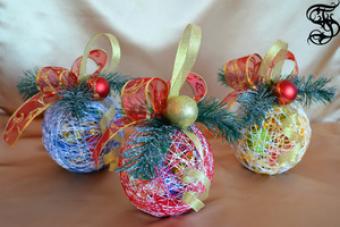The dragon is a symbol of 2012. In this master class I will show you how to make a dragon from beads with your own hands. For work we need: beads, wire, fishing line, beading needle and good mood.
Below are all the basic patterns required to weave a dragon from beads. I took this scheme as a basis, modernizing it as we weave it. If you weave on a wire, then you probably faced the problem of terminating the ends. In my scheme, I tried to reduce as much as possible the number of extra wire "tails" that need to be hidden somewhere. I hope this will not confuse you too much.
We put on one end of the wire 6 beads of blue color, place them in the middle. Let's pass the second end of the wire towards the first one through 3 beads, as in the photo below. We continue weaving according to the pattern. The odd rows will become the dragon's belly, and the even ones will become the back. For the eyelet, you can take black or dark beads, you can use larger beads. I made my little dragon such blue shiny eyes, because with black ones, it turned out well, very angry.
We will make ears according to the scheme. We work with one end of the wire. Let's pick 2 blue beads, 1 darker bead (I have a transparent blue bead), again 3 blue beads, 5 darker beads. Having passed the last set of beads, we will pass the wire in the opposite direction through 4 beads. It turns out the ear. Let's pick up another darker bead and 2 blue beads.
Now we pass the second end of the wire through 2 blue beads, 1 transparent, 3 blue and make a second eyelet: pick up 5 transparent beads and pass the wire in the opposite direction through 4 beads, just like with the first eye. Then we pass the end of the wire through the remaining 1 transparent and 2 blue beads of the row. Here is such a difficult series.
Next, we continue weaving according to the pattern, rounding the rows so as to give the dragon's neck and body a rounded shape. To give rigidity to our future toy from beads, you can fill the body with padding polyester. I did it without any hesitation, because I know for sure that if suddenly my dragon falls into the hands of my youngest daughter, then without dense packing it will definitely turn into a shapeless lump. And it is VERY difficult to restore the lost shape.
Next, weave the second side until we weave all the rows. A third of the work has already been done. Let's start with the front legs. On a piece of wire we string 1 white bead (claw) and 1 blue one, thread the second end of the wire through the blue bead in the same direction as the first one, as in the photo below.
Pick up one more blue bead, 1 white one and pass the wire back through the blue bead. So let's make another finger with a claw. Then we collect 1 white and 2 blue beads, and pass the other end of the wire only through the blue beads. Before tightening the row, twist the wire around the remaining loose white bead. Next, we will perform the required number of rows according to the scheme.
The legs are so long. Let's shorten and thicken them, collecting rows of beads with an accordion (photo below). Let's perform the second front leg in the same way. The hind legs are woven in the same way.
The dragon's wing is woven in the following sequence: first the skeleton is made, and then the wing is formed. Let's start with the longest first bone. Weave 50 identical rows of 1 bead each. Let's assemble the finished weaving "accordion", as in the photo below. Then we will weave the third "bone" from 31 rows, in the same way we will collect. Take one end of the wire from the first "bone" and one end from the third and weave a second "bone" of 37 rows on them. In general, every detail can be performed on a separate wire, but personally I like this option better. The fewer excess ends of the wire are eventually hidden, the neater our beaded toy will look.
The photo below shows what should happen. We will also collect a long "bone". You can start the fourth. On the right in the photo below you can see how you can proceed to continue weaving at the existing ends of the wire.
We collect beads and weave another "bone" from 25 rows of beads. Our next bone consists of 17 rows of 2 beads. Right photo below.
Let's put it together with an accordion.
Next, we work with one end of the wire. In order to avoid unnecessary "tails", we put 6 beads on one end (central photo below), pass the wire through 3 and 4 dialed beads, as in the photo on the right.
Now let us pass the end of the wire through the beads 1 and 2 in the same direction as they were drawn on the wire. It will turn out as if 3 rows are woven (left photo below). We pass the second end of the wire through the penultimate row and now we will continue weaving according to the scheme already at 2 ends of the wire. 19 rows of 2 beads. The photo on the right shows what will happen in the end.
Connect all the "bones" together, hiding all the extra ends of the wire. Now you can start designing the wing. In general, according to the scheme that I took as the basis for my dragon, the wings are also woven on a wire. But to be honest, I don't really like working with wire. At this stage, my wire began to break, bend ... in general, nothing worked for me. And since I really wanted to finish weaving the dragon, I found another option. Fishing line and needle. In the same way as in the version with wire, catching the wire between the rows of our "bones" on the fishing line, pick up the required number of beads according to the scheme and grabbing the wire of the next "bone", pick up the next row. It turns out faster and more convenient.
Beading is a fun activity. It's worth starting with simple elements, but sometimes you want something complex and unusual. Weaving a dragon from beads is not an easy task. Experienced needlewomen can easily cope with this task, and for beginners it is better to use the pattern for weaving a dragon from beads.
Having learned such a complex weaving technique, you can turn your hobby into additional income. After all, manual work is highly appreciated, and people are ready to give a lot of money for individuality.
From the dragon you can make:
- trinket;
- brooch;
- hair clip;
- decoration for a backpack or bag;
- necklace.
Determining the execution method
The dragon can be created in several ways. Each of them is interesting and unique in its own way.
Parallel
A beaded dragon looks very impressive in this technique. Parallel braiding is the most popular technique. It consists in passing the line through the bead towards each other. This creates short parallel rows that are fastened together.
A beaded Chinese dragon woven this way is a great option for beginners. Dragon beading will help you move to a new level, despite the fact that the technique is easy, you need to make a lot of effort.
Volumetric
A voluminous beaded dragon will be an excellent gift, it can be woven according to the pattern. The technique is quite difficult, you need to use the knowledge gained at the master classes to get it right. The basis is parallel weaving, but there are a number of differences. In the third row, the wire is rotated 90 degrees, due to this, the rows form the volume of the figure.
![]()
Color spectrum
The dragon is a mythological and fantastic creature. This means that you can choose a color based on your own imaginations. There are dragons in films and cartoons that viewers love.
You can create an image of one of these characters:
- Toothless from the cartoon "How to Train Your Dragon";
- Drakosha from the cartoon "Shrek";
- Mushu from the cartoon "Mulan";
- Haku from the anime film Spirited Away;
- Falkor from The Endless Story;
- Drakosha Tosh from the cartoon of the same name;
- Narissa from the movie "Enchanted";
- Azimondias from the cartoon "The Dragon Prince".
Based on the images of these characters, you can choose a color scheme for your craft. The combinations look interesting:
- green and red;
- black and red;
- gold and red;
- blue and white;
- black and gold;
- multicolored.
Necessary materials
Beading tools can be found in every home. Let's tell you more about the materials.
![]()
Beads
The quality of the product depends on the quality of the material. Therefore, you should not save on beads.
Major manufacturers of beads are:
- Japan;
- Czech Republic;
- China.
In Russia, only a few workshops are engaged in the production of beads, so our country cannot be called a mass producer.
Japanese seed beads are appreciated in the markets due to their special technologies and high quality techniques. The beads are uniform and of the same size. The price for such material is high, but ready product sold for a lot of money and equates to a work of art.
It is famous for its huge color palette. In terms of homogeneity, it is slightly inferior to Japanese, but if you buy beads from one batch, they will be even and neat. The price category in the markets is average.
Chinese beads are the cheapest material. It is used by beginners to familiarize themselves with the techniques and methods of weaving. Also, Chinese beads are suitable for glue bead paintings.
Beads
Large beads can become an accent in a craft. They are used for peephole in animals or edging in jewelry.
![]()
Beads create from different material with multifaceted coating:
- glossy;
- matte;
- rainbow;
- gasoline;
- glass;
- transparent glossy;
- transparent matte;
- metal;
- wooden;
- imitating precious stones;
- imitating pearls.
The following tools will also come in handy:
- wire;
- pliers;
- round nose pliers.
Various weaving patterns for beginners
There are many patterns for weaving a dragon from beads. There are complex ones, there are easier ones.
![]()
We will briefly tell you how to weave a dragon from beads for beginners:
- take beads of the desired colors;
- take a wire 3 m long;
- the body needs to be woven in a volumetric technique;
- the wings will be flat and held by the elasticity of the wire;
- when weaving the body, the rows are performed from top to bottom and vice versa;
- a filler is added to the body for volume;
- for the torso, a wire with a length of 120 cm is needed;
- it's worth starting work from the head;
- odd rows make up the upper part of the body, even rows make up the lower;
- paws are woven in the same way;
- for wings volumetric weaving not used.
Now you know how to make a dragon from beads. It remains to consider detailed diagrams and do a similar job.
Detailed description of the process
Head weaving
- Place 6 beads on one end.
- Place them in the middle.
- Pass the end through three beads (you should get a loop).
- Then weave in the same way.
- Use larger beads for the eyes.
- Round your neck and head gently.
![]()
Making ears
Work process:
- Cast on 11 beads in different shades.
- Pass the outermost bead, passing in the opposite direction through 4 beads.
- You will get an eyelet loop.
- Cast on 3 more beads in different shades.
- Create the second eyelet following the same pattern.
Creating the base of the torso
To weave the body of a dragon from beads according to the pattern, you can prepare the base in advance.
The following weaving features should be considered:
- When weaving, you need to round the corners.
- Even rows are rounded up.
- Odd down.
- Add padding or base for volume.
![]()
The beaded dragon is almost ready, it remains to weave the dragon's paws and wings according to the pattern.
How to weave the paws of an animal?
Working process:
- The limbs are braided in a parallel manner.
- Add white beads to the ends of the wire, these will be the claws.
- Add beads of a different color and pass the other end of the wire through it in the same direction.
- Make the required number of rows.
- Compact the rows before attaching.
![]()
Pulling on and securing the wings
Work progress:
- Create a skeleton for the wings.
- Fill in the space with beads between the seeds.
- Use the wire to secure the wings to the torso.
![]()
![]()
Photo source: https://biser.life/uploads/posts/2017-06/1497781062_1497262759_shema-4.jpg
Assembling the whole structure
Now you know how to make a beaded dragon.
It remains to collect all the elements together and put the craft on the shelf to admire your work of art:
- Pass the ends of the wire on the legs through the body.
- Fasten carefully.
- Mask the ends.
- Collect the beads gradually, clinging to the arc of the body.
![]()
The master class "How to make a dragon from beads" has come to an end. Feel free to experiment and try to create new products.
How to hang on a keychain?
If your dragon turned out to be small, you can hang it on a keychain and it will always be near you. Also, the beaded dragon keychain will be an excellent gift for any occasion.
What needs to be done:
- Buy a keychain blank.
- On the dragon, attach a loop of wire to the head or torso (do not make the loop in a fragile place).
- Attach the eyelet to the workpiece.
Your product is ready. If you put in the maximum patience and work, then you probably succeeded. A beaded dragon is not an easy product, it requires a lot of effort and time. But finished craft will show your knowledge in beading and will always remind you of your hard work.
![]()
![]()
![]()
![]()
![]()
![]()
![]()
![]()
![]()
![]()
Figures and figurines made of beads are a very popular trend in beading. In order to make your first figurine, you only need a diagram and desire. Having purchased the required material, get to work and very soon a cute little dragon or parrot will decorate your home.
This hobby can captivate you so much that an infinite number of beaded figurines, butterflies and many others will decorate your home. Or become good gift to any event.
Today we offer you dragon creation workshops. They can be woven different ways, but the most beautiful dragons are obtained with volumetric weaving.





Parallel dragon weaving pattern
To weave this wonderful Drakosha, you need beads of light green, dark green, black and brown color and a wire with a thickness of 0.3-0.5 mm and a length of 3 m.
The wings of the dragon and the body are woven in the same technique - parallel weaving. Due to the stiffness of the wire, the required volume is created, and the wings are woven flat. When weaving the body, the rows are performed from top to bottom and vice versa, there is no need to put filler inside the figure, the volume will be sufficient.
To weave the body, cut off a wire 120 cm long, start work from the face. The volume of the figure is obtained by bending the wire of odd and even rows. The diagram shows that the rows are split in pairs and separated by a bar. Odd rows make up the upper body, even rows make up the lower. Accordingly, in odd rows, try to bend the wire upward, in even rows - downward. When weaving paws and wings, as the diagram shows, volumetric weaving is not required. Make sure that the rows lie flat, because after the completion of the work, it will be impossible to straighten the crumpled and skewed places. The diagram shows the locations marked for attachment of the dragon's elements to the body. When you reach the point of attachment of the horns or paws, an element is woven on an additional wire, which is attached to the body and the weaving continues.
This master class is very useful for those who are just starting to beadwork. After all, if you slightly modify the basic scheme, you can weave a crocodile or a snake, and if you go even further, then come up with many other figures based on one principle of weaving.
In those places of the diagram where there are no dividing lines, it means that the weaving goes into one plane. You can see this in the tail area.
Master class on creating an oriental dragon amulet
 This unusual amulet will appeal to lovers of oriental arts; it can serve as a keychain or a pendant. If you give such a dragon to a connoisseur, then a unique gift will bring real joy to the owner, become his amulet and a symbol of his strength.
This unusual amulet will appeal to lovers of oriental arts; it can serve as a keychain or a pendant. If you give such a dragon to a connoisseur, then a unique gift will bring real joy to the owner, become his amulet and a symbol of his strength.
To weave this mysterious dragon, you need to purchase beads and a large bead, around which we will weave and beads of various sizes. I would like to say right away that this master class is of increased complexity, and if you are not very experienced in weaving from beads, then this lesson on beading may not suit you. Try to make Drakosha from the first master class first.
We need:
- large base bead;
- beads different sizes: №№6, 8, 11, 15;
- thin wire or fishing line.
We start weaving around the largest bead. We string it on a thin cord and begin to braid it. We bend over half of the bead with a cord and proceed to braiding. The first row is made of beads # 15.
 We continue to weave rows around the bead following the first: 2 p. - gray beads No. 15, from 3 to 5 rubles. - alternation of 1 gray and 2 black beads No. 15, 6 rubles. - black beads No. 11, 7 p. - black seed beads # 8. We fix and cut the end of the thread.
We continue to weave rows around the bead following the first: 2 p. - gray beads No. 15, from 3 to 5 rubles. - alternation of 1 gray and 2 black beads No. 15, 6 rubles. - black beads No. 11, 7 p. - black seed beads # 8. We fix and cut the end of the thread.
 Now in the 8th row we alternate black beads with elongated beads, as seen in the photo. There will be 9 or 10 of them.
Now in the 8th row we alternate black beads with elongated beads, as seen in the photo. There will be 9 or 10 of them.
 Weave the body of the dragon as shown in the diagram. It turns out a kind of tourniquet. The large dots mark the eyes on the diagram, the smallest burgundy dots indicate the final row that forms the neck.
Weave the body of the dragon as shown in the diagram. It turns out a kind of tourniquet. The large dots mark the eyes on the diagram, the smallest burgundy dots indicate the final row that forms the neck.


Now the dragon's crest is next. We braid 6-8 black beads on the head of the amulet - in the photo they are marked with red dots.
On the basis of these beads we weave a triangular element, which narrows in the area of \u200b\u200bthe eyes, so that it looks like a comb.
At the same stage, we attach a ring at the base of the ridge, for which it will be possible to hang our amulet. To do this, we make a simple chain of beads, string a ring onto it.
Pass the fishing line several times in a circle so that the ring is fixed as tightly as possible. We finish the comb on the head, sharpening it up.




Now let's take care of the dragon's tail. Weave the tail in the same technique. As for the body, we make it by the end of the tail - up to 7 beads. Before narrowing, you need to make several rows in brick technique.
 Then we go to beads # 15. If you look closely at the photo, you can see that the narrowing of the tail begins from the middle of the main bead.
Then we go to beads # 15. If you look closely at the photo, you can see that the narrowing of the tail begins from the middle of the main bead.
 After 3 rows of black beads are woven, add golden beads and weave 2 more rows in brick technique.
After 3 rows of black beads are woven, add golden beads and weave 2 more rows in brick technique.
 To make the tail look complete, we decorate it with a comb, just like the head. We start with 4 extra beads. Then we continue weaving on them.
To make the tail look complete, we decorate it with a comb, just like the head. We start with 4 extra beads. Then we continue weaving on them.
Various bead crafts can be a decoration for any interior. You can create anything you want from beads - from jewelry to simple figures in the shape of flowers or animals. To create them, you do not need to have unique skills and big amount time because it is very simple. And the crafts look very gentle and cute.
The dragon is generally capable of decorating anything from the lapel of a coat to the wall in your living room. It does not matter - whether it is a brooch, a keychain or a panel in the sgraffito technique: the dragon is beautiful in itself, and it is absolutely all the same whether it is Toothless from a children's cartoon, or a Chinese fire or sea dragon. And made with your own hands, he will surely give a lot of positive emotions.
In order to make any figurine, you need to have a great desire, scheme, materials and a little free time. And also - mk with diagrams and a training video.
Now, you will be asked to make a decorative dragon from beads, the scheme of which can also be found on the Internet, using the technique of volumetric weaving with the help of a master class that will perfectly fit into your apartment or will become a wonderful, amazing gift.
First, we will decide on colors and the technique of weaving our dragon. You can choose absolutely any shades, it all depends on your imagination.
For example, we take light blue, dark blue, white and transparent beads, as well as wire 0.5 millimeters thick and three meters long. The main thing here is to take the wire, and not the line, because the dragon must be large and curly.
Gallery: beaded dragon (25 photos)



























Let's start weaving
Both the wings and the body of the product are made using parallel weaving techniques... When creating a torso, it is necessary to weave rows from bottom to top and vice versa. It should be noted that there is no need to fill the inside of the product, because the wire will give the required volume anyway. Although, if children are to play with the figure, you need to fill it with padding polyester so that the volume of the thing is not damaged. The wings will turn out to be flat. The scheme for creating a dragon from beads, master class.

Weaving a new row, master class
Let's select beads and create a row of twenty-five beads. Then we will weave 17 rows of two beads each and collect everything with an accordion. We continue to work, using one end of the wire, for this we collect six beads and thread the wire through the third and fourth dialed beads. Description of beading:

That's all, the dragon is done! This master class will be useful to all beginners, because by slightly changing the scheme, you can make another animal, for example, a snake or a crocodile.
The dragon is a symbol of 2012. In this master class I will show you how to make a dragon from beads with your own hands. For work we need: beads, wire, fishing line, beading needle and good mood.
Below are all the basic patterns required to weave a dragon from beads. I took this scheme as a basis, modernizing it as we weave it. If you weave on a wire, then you probably faced the problem of terminating the ends. In my scheme, I tried to reduce as much as possible the number of extra wire "tails" that need to be hidden somewhere. I hope this will not confuse you too much.




We put 6 blue beads on one end of the wire and place them in the middle. Let's pass the second end of the wire towards the first one through 3 beads, as in the photo below. We continue weaving according to the pattern. The odd rows will become the dragon's belly, and the even ones will become the back. For the eyelet, you can take black or dark beads, you can use larger beads. I made my little dragon such blue shiny eyes, because with black ones, it turned out well, very angry.



We will make ears according to the scheme. We work with one end of the wire. Let's pick 2 blue beads, 1 darker bead (I have a transparent blue bead), again 3 blue beads, 5 darker beads. Having passed the last set of beads, we will pass the wire in the opposite direction through 4 beads. It turns out the ear. Let's pick up another darker bead and 2 blue beads.
Now we pass the second end of the wire through 2 blue beads, 1 transparent, 3 blue and make a second eyelet: pick up 5 transparent beads and pass the wire in the opposite direction through 4 beads, just like with the first eye. Then we pass the end of the wire through the remaining 1 transparent and 2 blue beads of the row. Here is such a difficult series.



Next, we continue weaving according to the pattern, rounding the rows so as to give the dragon's neck and body a rounded shape. To give rigidity to our future toy from beads, you can fill the body with padding polyester. I did it without any hesitation, because I know for sure that if suddenly my dragon falls into the hands of my youngest daughter, then without dense packing it will definitely turn into a shapeless lump. And it is VERY difficult to restore the lost shape.



Next, weave the second side until we weave all the rows. A third of the work has already been done. Let's start with the front legs. On a piece of wire we string 1 white bead (claw) and 1 blue one, thread the second end of the wire through the blue bead in the same direction as the first one, as in the photo below.


Pick up one more blue bead, 1 white one and pass the wire back through the blue bead. So let's make another finger with a claw. Then we collect 1 white and 2 blue beads, and pass the other end of the wire only through the blue beads. Before tightening the row, twist the wire around the remaining loose white bead. Next, we will perform the required number of rows according to the scheme.



The legs are so long. Let's shorten and thicken them, collecting rows of beads with an accordion (photo below). Let's perform the second front leg in the same way. The hind legs are woven in the same way.



The dragon's wing is woven in the following sequence: first, the skeleton is made, and then the wing is formed. Let's start with the longest first bone. Weave 50 identical rows of 1 bead each. Let's assemble the finished weaving "accordion", as in the photo below. Then we will weave the third "bone" from 31 rows, in the same way we will collect. Take one end of the wire from the first "bone" and one end from the third and weave a second "bone" of 37 rows on them. In general, each detail can be performed on a separate wire, but personally I like this option better. The fewer excess ends of the wire are eventually hidden, the neater our beaded toy will look.



The photo below shows what should happen. We will also collect a long "bone". You can start the fourth. On the right in the photo below you can see how you can proceed to continue weaving at the existing ends of the wire.



We collect beads and weave another "bone" from 25 rows of beads. Our next bone consists of 17 rows of 2 beads each. Right photo below.






Now let us pass the end of the wire through the beads 1 and 2 in the same direction as they were drawn on the wire. It will turn out as if 3 rows are woven (left photo below). We pass the second end of the wire through the penultimate row and now we will continue weaving according to the scheme already at 2 ends of the wire. 19 rows of 2 beads. The photo on the right shows what will happen in the end.



Connect all the "bones" together, hiding all the extra ends of the wire. Now you can start designing the wing. In general, according to the scheme that I took as the basis for my dragon, the wings are also woven on a wire. But to be honest, I don't really like working with wire. At this stage, my wire began to break, bend ... in general, nothing worked for me. And since I really wanted to finish weaving the dragon, I found another option. Fishing line and needle. In the same way as in the version with wire, catching the wire between the rows of our "bones" on the fishing line, pick up the required number of beads according to the scheme and grabbing the wire of the next "bone", pick up the next row. It turns out faster and more convenient.





